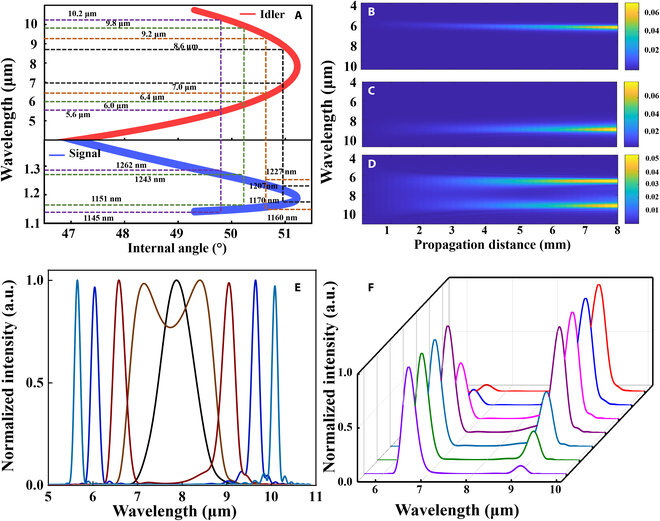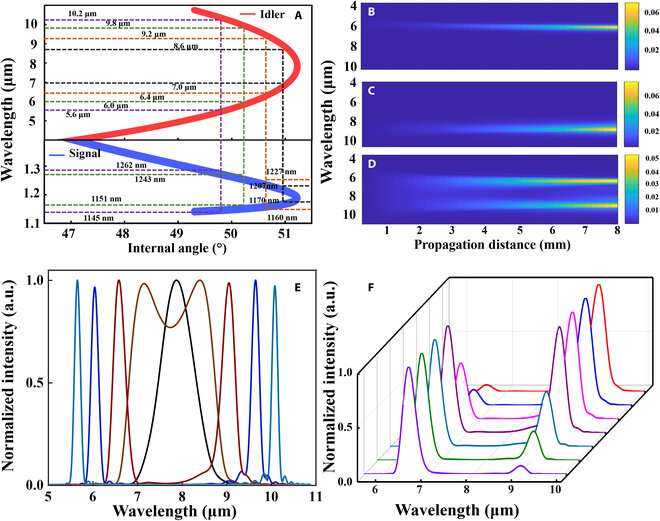

Multi-wavelength femtosecond pulses with flexible tunability in both the temporal and spectral domains have been widely desired, owing to their potential applications in controlling strong field ionization, electron dynamics, and high-order harmonic generation. Particularly, ultrafast pulses coherently synthesized by multiple spectral bands are thought to be an ingenious instrument to harness or enhance high-harmonic generation(HHG).
For the aforementioned applications in strong-field physics, mid-infrared (MIR) lasers attract substantial research efforts, as the ponderomotive force scales quadratically with the driving wavelength. Therefore, MIR multi-wavelength-shaped pulses are in high demand. However, the existing methods for generating multi-wavelength pulses lack freedom in spectral tuning and require sophisticated apparatus for complicated phase and noise control.
Recently, researcher Houkun Liang, of Sichuan University’s College of Electronics and Information Engineering, and his team proposed a relatively simple and compact method to generate MIR pulses with dual-wavelength spectral shaping and exceptional freedom of tunability in both the lasing wavelength and relative spectral amplitudes by combing Martinez compressor and optical parametric amplifier based on LGS crystal. Their paper is published in the journal Ultrafast Science.
The output MIR spectra exhibit two tunable means:
- When the dispersion is completely compensated, different dual-wavelength pairs at 5.6, 10 μm; 6.0, 9.6 μm; 6.6, 9.0 μm; 7.1, 8.4 μm; and 8.2 μm with a maximal average power up to 280 mW and a power efficiency of 2.8% at the repetition rate of 50 kHz by adjusting the phase match angle;
- When the dispersion is partly compensated, the relative spectral amplitudes of a specific dual-wavelength pair can be arbitrarily changed by controlling the pump delay.
To test the usefulness of the demonstrated high-power MIR light source with dual-wavelength spectra shaping features, HHG is driven by MIR dual-wavelength tunable pulses in a 3-mm-thick polycrystalline ZnSe plate. Thanks to the dual-wavelength tunability, the acquired HHG spectra have traits of spectral shaping of HHG with multiple groups of harmonics in both the spectral position and relative strengths.
MIR ultra-short pulses with outstanding freedom in multi-wavelength spectral shaping can trigger more advanced applications such as enhancement of HHG, THz wave generation, tunable intra-pulse difference-frequency generation, attosecond metrology, and controlling electron localization in molecular dissociation. Moreover, the demonstrated HHG steering method could open new possibilities in exploring femtosecond control of electron dynamics and light-matter interaction in composite molecular systems.
More information:
Linzhen He et al, Dual-Wavelength Spectrum-Shaped Mid-Infrared Pulses and Steering High-Harmonic Generation in Solids, Ultrafast Science (2023). DOI: 10.34133/ultrafastscience.0022
Provided by
Ultrafast Science
Citation:
Dual-wavelength lasing: A new tool for steering high-harmonic generation (2023, May 30)
retrieved 31 May 2023
from https://phys.org/news/2023-05-dual-wavelength-lasing-tool-high-harmonic-generation.html
This document is subject to copyright. Apart from any fair dealing for the purpose of private study or research, no
part may be reproduced without the written permission. The content is provided for information purposes only.